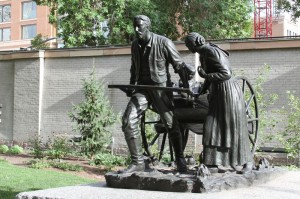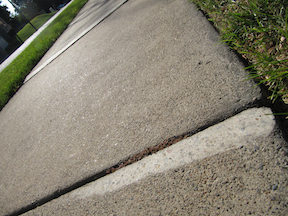Mormons and midwives, or A tale of two shuttle rides
10 October 2012 – Cathy Stanton
I got my first sense of how present the Mormon past is in Salt Lake City on the shuttle ride from the airport to the convention center where the American Association for State and Local History conference was taking place. The friendly woman in the seat behind me explained that she and her family were in town for the semi-annual Mormon general conference, and pointed out that you can still see the sweep of the founders’ vision in the extraordinary four- or even six-lane width of most of the major streets. “They were really thinking on a grand scale,” she said, and went on to mention the hardships that the Mormon pioneers had faced in their westward trek to their Promised Land. She gave me some tips about things to make sure to see in Temple Square, which I found, when I went there the next afternoon, to be just as filled with markers and references to the Mormon origin story as I’d expected it would be.
Memorializing a heroic and foundational past is of course not unique to Mormonism, but I was struck by the particular intensity of it in this case. It seems linked to the relative recentness of that founding period and the ambivalent role that Mormons have played–exemplary and exotic at the same time–within American society. Nicholas Lemann comments on this same intensity and ambiguity, and the resulting need to honor and perhaps redeem the past, in “Transaction Man,” his excellent piece in the New Yorker on how family, religion, and a particular business ideology have combined to form Mitt Romney as a Presidential candidate. And the same sense of an intensely reverberating past also came through in Laurel Thatcher Ulrich’s plenary address for the AASLH, which I arrived just in time to hear.
Ulrich herself has Mormon roots, and she’s well-known for her ability to draw out richly meaningful inferences from seemingly ordinary records, such as the Maine midwife’s diary in which she found evidence of political and emotional drama between the purely factual lines (A Midwife’s Tale: The Life of Martha Ballard, Based on her Diary, 1785-1812, Knopf, 1990). Her current work focuses on the diary of Patty Sessions, another midwife who migrated from Maine to Salt Lake City with the great Mormon exodus of the 1840s. The drama of this history is more overt–the mass movement of 15,000 refugees, the ongoing displacement of Native Americans, antebellum conflicts over slavery–but Ulrich still concentrates most of her attention on the small details, finding in them the kind of nuance that larger-scale histories often don’t capture.
For example, her reading of Sessions’ diary illuminates a paradoxical strand of 19th century feminism within the hyper-paternalistic Mormon sect, with all-female councils advocating energetically for health and clothing reform, education and voting rights for women (Utah women actually won the vote in 1869, but it was taken away again by the state after they exercised it—again, paradoxically—in favor of polygamy). Ulrich is adept at linking these larger movements to individual experiences; I could feel the audience responding emotionally, as I did, to her description of how, after many trials and tribulations (and the delivery en route of 52 babies) on the long journey from Illinois to Utah, the pioneers thought it fitting that it was Patty Sessions’ hands that caught the first male Mormon child born in the Promised Land.
Like Ulrich, Nicholas Lemann skilfully connects broad context to individual lives in his profile of Mitt Romney. A particular strength of this piece is how it situates Romney’s business success within the macro-economic shift into the newly-“financialized” economy of the 1980s. In Lemann’s account, the seemingly clear-cut goals of that economy—simply to move money around as efficiently as possible in search of added value—suited the ingrained Mormon preference for clear, practical, orderly organizational strategies and a leadership style that’s all about just getting things done. In Salt Lake City, where even the sidewalks are neatly ground down to take off any uneven edges, it was useful to me to have Lemann’s insights into some of the origins of that rage for orderliness, just as it was useful to hear Ulrich’s fine-grained reading of the internal contradictions within 19th century Mormonism that continue to make themselves felt today.
As with all good historical thinking and writing, though, I have to wonder how far into general awareness it actually permeates. This is of course the core question for public historians, and during an election season, when sound-bites and attack ads prevail, it can be a depressing one to contemplate. This was brought home to me on my shuttle ride back to the airport on Sunday morning, when the driver recited the well-worn tale of how Mitt Romney single-handedly rescued the 2002 Winter Olympics. “You must be very proud of your governor,” she said, and failed to grasp my response that like many people from Massachusetts, I don’t actually think of Mitt as “our governor,” since he so clearly parachuted into the role only as a staging area for his first Presidential run. I try to resist the “barbarians at the gates” interpretation of what’s happening in American popular and political culture, but at that moment, the nuances of careful, critical thinking about the past seemed a long way away. It was disturbing, but it also reminded me of why I’ve made public history my disciplinary home. It lets me exist somewhere in between the “received” narratives of my two shuttle conversations and a more questioning approach to history, and enables me to be a part of the search for ways to bridge the gap—which sometimes feels like a yawning chasm—between them.
~ Cathy Stanton, Tufts University







2 comments